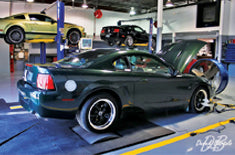Steeda X2 Mustang Balljoints (94-04) & (79-93 w/ SN95 Knuckle)
By: Steeda
#555-8101
$275.99
-
Product Benefits
- Restores front end roll center geometry
- Improved front end grip and steering response
- Reduced understeer at cornering limit
- High quality construction
-
-
Time Required: 1 hour (approximately)
-
Skill Level: Beginner - No mechanical experience is required to perform this installation.
-
-
-
Mustang 1999-2004 GT
-
Any time you alter the height of your ride, as you do when you install lowering springs (like our Steeda Sport Springs), you upset the suspension geometry. Your roll center geometry as well as your bump steer geometry is affected. You can easily bring your front roll center geometry with a set of our X2 ball joints.
Note: Fox Body Owners the Steeda X2 ball joints will work with 1979-1993 Mustangs, however you will need to swap to 1994-2004 spindles and brakes. The knuckle on the Foxbody spindle is thicker then the knuckle on the 94-04 spindle and does not allow for proper thread engagement for the top nut of the X2 ball joint.
Steeda's X2 Balljoint improves suspension geometry on lowered Mustangs by raising the spindle relative to the balljoint pivot-point. This raises the roll center back into the correct range for optimum handling, resulting in reduced body roll, quicker steering response and improved overall front tire grip. Steeda's special balljoint reduces the need for oversize front swaybars and allows the use of lower front spring rates, creating more grip over uneven pavement and better ride quality.
Why is this important? When a Mustang is lowered, the front roll center changes due to the new position of the suspension pivot points. Lower the car too much and the front roll center drops to well below ground level, and worse than that, the roll center moves side to side as the body rolls, resulting in lost grip and erratic handling. The lower roll center causes the body to roll more easily. Countering this tendency usually requires a significant increase in front spring rate to simply control the added roll due to the lowered the roll center. This higher spring rate not only hurts ride quality, but it also reduces grip on rough surfaces, as the stiffer springs cause the tire to skip over bumps instead of following the contours of the road. The X2 balljoint was designed to eliminate these problems by correcting the front roll center geometry. The X2 balljoint has a longer shaft, to raise the spindle relative to the balljoint pivot point. Spacers for the springs are included in the X2 kit to maintain the same ride height as a stock balljoint, but with a much improved roll center height. With the roll center restored to the proper height the result is a suspension that works for you to accommodate the small and large imperfections that are in any road or track, allowing the tires to stay planted and provide better front end grip.
Construction
Steeda ball joints are made in the USA to our specifications by a respected name-brand supplier to Ford, GM and Daimler Chrysler. Except for their custom length, they are the same materials and construction that has been extensively tested in Panther applications, that is, police cars and other severe duty applications, where they have demonstrated durability that exceeds current production "regular" balljoints. They meet Ford's standards for friction, wear, and durability.
Important Details
Because the balljoint changes the relationship between the lower control arm and the tie-rod, bump-steer should be checked whenever the X2 balljoint is installed. Particularly if caster/camber plates are being used. With stock caster settings, offset rack bushings can sometimes be enough to keep bump-steer within acceptable range. However, when caster is increased, the rear inclination of the spindle further raises the steering arm where the tie-rod attaches. Therefore, an adjustable tie rod end, commonly called a bump-steer kit, is highly recommended to prevent bump-steer whether or not caster camber plates are used in combination with the X2 balljoint.
Related Items
Steeda Mustang Coupe Full-Length Jacking Rails (2015-2024)
$332.35
25% lighter than the competition, only 11.6 lbs! Allows you to jack up your S550/S650 anywhere along the jacking rail, preventing damage to your factory... View full product details
ALIGNMENT KIT Camber (2015+ Mustang)
$80.90
Precision alignment kits for maximum performance Prevents uneven tire wear Corrects excessive negative camber Wider range of camber adjustment - suitable for street or track... View full product details
Steeda S550/S650 Mustang Ultralite 2-Point G-Trac Brace (2015-2024)
$250.70
Improves chassis stiffness and suspension compliance Weighs in at a mere 5.5 lbs, over 50% lighter than the competition Extremely compatible with other aftermarket components... View full product details
S550 Mustang Rear IRS Subframe Support Braces
$629.05
Better handling for more stable cornering Limits IRS sub frame movement No permanent modifications necessary No added NVH 50% more connecting points Reduces wheel hop... View full product details










